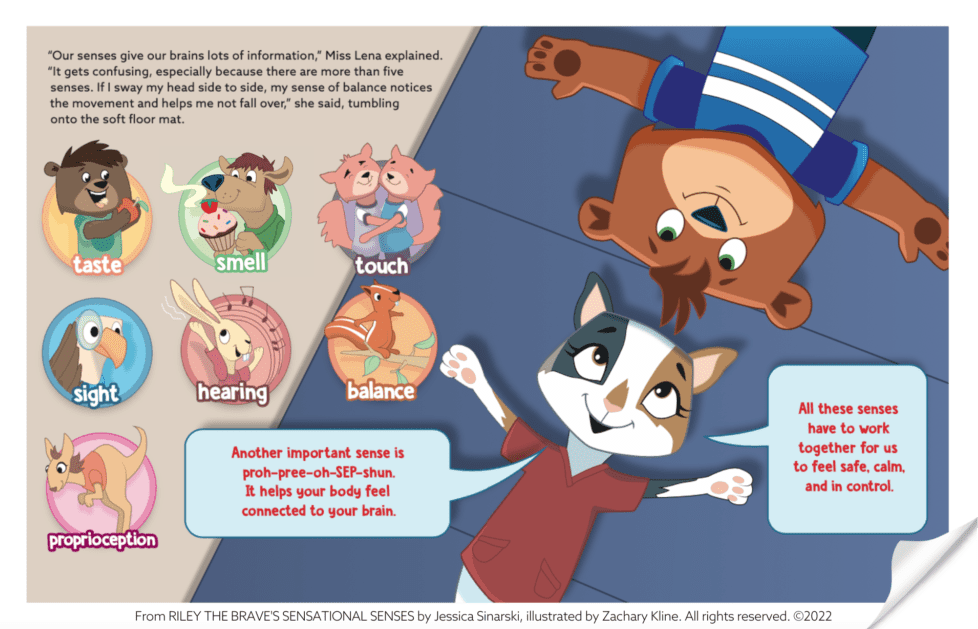How learning about sensory processing changed… everything.
My brilliant little 4-year-old son was asked to draw a house at preschool and burst into tears. Bursting into tears was a common occurrence for him, as was picky eating, complaining about jeans and shirt tags, banging into things, difficulty transitioning from one task to the next, slouching posture, and what I came to realize were a whole host of sensory red flags.

Sensory processing difficulties occur when the brain has trouble receiving, interpreting, and responding to information coming in through the senses.
But how does all this relate to not being able to draw a house at preschool?
My eyes were about to be opened to the complexities of the senses!
When I first dipped my toe into the world of sensory processing, I have to admit…it sounded a bit far-fetched.

And yet…there was something here that felt right.
We started doing “steam rollers” along his back and big “super slams” before bed. It was physical and full of laughter, just what you would think would amp up a little kid. Instead, he would sigh and say, “Ahhhh. Now I’m ready for sleeps.”

So I dug in.
Books, research articles, information from respected organizations like the STAR Institute and ATTACh all confirmed that this wacky task of making sense of our senses really matters! We found some quality occupational therapy for my son, which, like so many mental health and wellness services, can be difficult to track down. It made such a big difference!
I kept learning everything I could. I started integrating this newfound sensory lens into my therapy practice and found the same positive results.
As my understanding of sensory processing has deepened over the last 10 years, I have continued to see time and time again how beneficial it is to get to know our sensational senses.

We have EIGHT senses
I am drinking my morning cup of coffee as I write this. My sense of TASTE and SMELL certainly love it (though yours may not, if coffee’s not your thing). My sense of TOUCH (often called the tactile sense) enjoys the warmth of the mug in my hand. I can hear the drizzle of rain, the sound of traffic, and the cawing of a crow out my window with my sense of HEARING, all while focusing my SIGHT on the words on the screen. But there’s a lot more going on than that. And our three hidden senses play a big role in behavior!
PROPRIOCEPTION
Proprioception [pro-pree-oh-sep-shun] is your body’s innate sense of its position, movement, and spatial orientation. Without it, you would feel like you were floating away in outer space (not in a fun way!!). It’s what allows me to know I’m not going to fall out of my chair, take a sip of my coffee without looking, and press the keys at the right pressure to type letters without breaking my keyboard. Think of it as your body’s internal GPS, constantly providing feedback to your brain about the position and motion of your limbs and joints.
At the heart of proprioception are specialized sensory receptors located in your muscles and joints. These receptors detect changes in muscle length, tension, and joint angle, sending signals to your brain that help coordinate movement and spatial awareness. Lots of swaddling, bouncing, patting, pushing, pulling, jumping, clapping, rough-housing, walking, running, and rolling around help give this important sense the input it needs during a child’s development. Many kids crave a lot more proprioceptive input than they get in the modern world.
VESTIBULAR
The vestibular sense is responsible for providing us with a sense of balance, spatial orientation, and coordination of movement. Receptors in the inner ear act like an internal gyroscope, constantly sending signals to the brain about the position and movement of our head (a pretty important part of the body). Not only is this sense essential for everyday activities like walking, running, jumping, and even sitting upright, but it also gives our brain lots of little details that help us feel emotionally stable.
For kids, the vestibular sense is particularly crucial. Beginning in utero, they instinctively seek out experiences that stimulate this sense, whether it’s rocking, swinging, or spinning. These activities not only provide sensory input but also play a vital role in their physical, cognitive, and emotional development. Lots of swaying, swinging, crawling, climbing, biking, dancing, and other movements feed this important sense.
INTEROCEPTION
The sensory receptors in our internal organs and skin also share important information with the brain all day long, often without us realizing it. It tells us things about temperature, pain, basic needs, emotional state, and so much more. This sense often gets muted or sensed in a more extreme or volatile way in the aftermath of trauma. Environments and activities that help kids feel safe and in control will help create space for increased awareness of this important sense. Every time we are able to pause and breathe and get curious with ourselves, we strengthen this critical internal sense.
All eight of our senses have to work together for us to feel safe, calm, and in control!
That’s why super slams helped my 4-year-old get to sleep, and 2 minutes on the trampoline can help him finish his math work. It’s why building core strength gave him the ability to work on his hand-writing, and chewing gum still helps him focus. Getting all the senses working together allows his brain to get the information it needs so he can learn, grow, and thrive!

But it’s complicated!
There’s no one-size-fits-all, here’s-a-quick-worksheet solution! Sensory processing is not widely understood and often gets overlooked as a factor in children’s behavior.
Our sensory systems are sending eleven million bits of information to the brain every second! Even though we are only conscious of, at most, 40–50 of those bits, it is easy to see how the brain can get flooded. When overwhelmed, the brain tends to produce some mixed-up feelings and frustrating behaviors, those “downstairs brain moments” you see in the Riley the Brave books.
Next Steps for Your Sensational Kids & Students:
- Check out Riley the Brave’s Sensational Senses for a kid-friendly introduction to the eight senses. This book has been life-changing for some families struggling with understanding their kids’ big behaviors.
- Build movement and big-muscle activities into the schedule. Frequent movement breaks, carrying heavy items, and body weight exercises are all great for the proprioceptive sense!
- Recognize that everyone’s sensory needs are different. While one kiddo might love the pressure of a weighted blanket, another may hate the sensation that comes with pressure.
- If you are parenting or working with children impacted by trauma, dig deeper with this on-demand webinar: Trauma & the Senses. Includes 1-hour continuing education certificate.
- Get curious and become a sensory detective! We see caregivers do this for crying babies: Is their diaper wet? Are they tired? Are they hungry? The same can be done as part of co-regulation as kids age. Do they hate that shirt because its tag is itchy? Would a fidget help them focus? Do they feel calmer after spending some time in plank pose?
- If you work in an education setting, check out Key 2 in Light Up the Learning Brain for an in-depth look at the senses and school.
When children do not behave the way we expect them to, it is often because they can’t… yet.
Fortunately, that is not the end of the story. When we help children understand what their senses need, we are literally helping them grow their brains. As I learned way later than I feel like I should have learned, tapping into the power of the senses will help kids develop their capacity to “feel and deal” instead of flipping into fight / flight / freeze (and the frustrating behavior that goes with). I am happy to report that being asked to draw a house no longer sends my son into a meltdown. He has learned ways to navigate frustration and get the sensory input he needs to be successful. I am confident that your kids / clients / students can too!